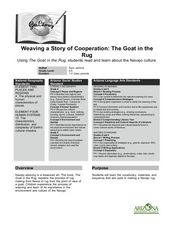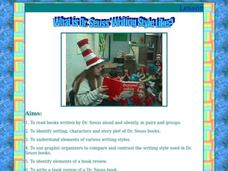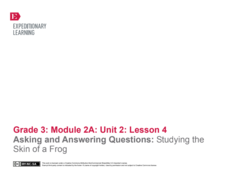Curated OER
Sequencing Life Cycles and Daily Activities
First graders sequence story situations. In this sequencing lesson plan, 1st graders read Charlie the Caterpillar and sequence his life cycle. Students role play the story parts and sing a song about metamorphosis.
Curated OER
Poetry Reading for ELL Beginners
Bring the imagery of the desert to your classroom with this ELL lesson plan. After reading Madeleine Dunphy’s Here in the Southwestern Desert, learners complete a graphic organizer about the features and images of the poem. The...
Curated OER
Weaving a Story of Cooperation: The Goat in the Rug
Weaving is an important part of Navajo culture. Read The Goat in the Rug to your fourth and fifth graders, and give them a glimpse into the process of rug making from the point of view of a goat! They will learn new vocabulary words and...
Curated OER
Sequencing: Pictures Tell a Story
Students listen to a story and observe five illustrations of the main events drawn by the teacher. They arrange the illustrations in sequential order. Then, working in groups of five, they read stories and select five events, one for...
Curated OER
Sequence Clue Words (part 2)
If you've already discussed using sequence words to determine the sequence of events in a story, then a follow up lesson is definitely in order. They read the story, My Apron by Eric Carle and look at the sequence clue words such as...
Curated OER
Retell a Story in Sequential Order
Second graders discuss sequential order. In this language arts lesson, 2nd graders practice retelling a story in sequential order. Students read a story and chart the events in sequential order.
Theodore Roosevelt Association
Theodore Roosevelt: A Presidential Timeline
Throughout his life and presidency, Theodore Roosevelt contributed to the America we know today in so many ways. An adaptable lesson prompts young historians to create a chronological timeline of Roosevelt's contributions to different...
AtoZ Teacher Stuff
Pumpkin Life Cycle
From seed to jack-o-lantern, young scholars walk step-by-step through the life cycle of pumpkins with this fun art and science activity. After first participating in a shared reading of the children's book Pumpkin,...
Curated OER
Zoom! Zoom! Zoom! I'm Off to the Moon Sequencing Lesson
Students practice sequencing. In this sequencing lesson, students listen to the book Zoom! Zoom! Zoom! I'm Off to the Moon. They put the story events in sequential order using a graphic organizer.
Curated OER
Sunrise Sequencing
Students examine sequencing events by discussing what they do each morning. They complete a four-panel sequence of events assignment, drawing a picture and writing a sentence for each box in the panel.
Curated OER
Retelling the Main Event in Sequence
Young scholars practice retelling the main ideas of a story in sequential order. In this story retelling lesson, students listen attentively to a story. They learn a song as they listen that helps them review the main ideas of the story...
Curated OER
Parts of the Plot: Constructing a Plot Diagram
Sixth graders conduct a plot diagram for a short story. They identify the problem, the rising action, the climax, the falling action, and the resolution. Students are able to sequence events in a story, and identify the parts of the plot...
Teachers' Domain
Sequencing: Princess Fairy Tales
Review with your young readers the course of events in typical fairy tales with princes, princesses, and dragons. Then read either The Paper Bag Princess by Robert Munsch or Princess Smartypants by Babette Cole to compare these two...
Curated OER
The Civil Rights Movement
Students learn about the civil rights movement and create a timeline to understand events in chronological order. In this history lesson, students work in groups to choose one activist from the Civil Right era to research. Students then...
Curated OER
Dr. Seuss
Learners read books by the same author and compare what they find. In this Dr. Seuss instructional activity, students learn about Dr. Seuss' writing style, listen for the rhyme scheme in his stories, and create a KWL chart on Dr....
EngageNY
Asking and Answering Questions: Studying the Skin of a Frog
English language arts and science combine in a lesson that focuses on asking and answering questions about frog skin. Discussion, a read-aloud, and partner work lead the way towards a three-page worksheet that tests learners'...
Guam Community College
Joseph Had a Little Overcoat
Spruce up a class reading of the children's book Joseph Had a Little Overcoat by Simms Taback with this fun series of activities. Starting with a list of reading comprehension questions and key vocabulary to address during a teacher...
Curated OER
One * Two * Three * Story
Second graders explore sequencing by drawing events of a story in order. In this sequence of events lesson, 2nd graders are read a story such as "The 3 Little Pigs", they recall the events from the fairy tale in order, visit an...
Curated OER
Sequencing Time
Learners place events in sequence and assign relative times to each event. They gain an understanding of relative and numerical time and become familiar with the methods used by scientists to develop the Geologic Time Scale.
Curated OER
Esperanza Rising: Lesson 8
Sixth graders complete activities with the book Esperanza Rising by Pam Munoz Ryan. In this literature lesson, 6th graders read Chapter 8 of the book and discuss the chapter. They practice putting events in sequence and record new...
Curated OER
Where Do We Begin?
Primary learners grasp sequence of events by discussing morning routines and reviewing the story of Little Red Riding Hood. They explore the necessity of correct order of events. As a class, create a story with a beginning, middle, and...
Curated OER
Order! Order!
Polish organization skills in your youngsters. With this lesson, they are introduced to the trait of organization and participate in activities that reinforce organization. They cut apart a familiar story, receive different...
Curated OER
Molly Pitcher -- "Out of Many, One"
Students research, brainstorm and analyze the events that lead up to the Revolutionary War. They critique a piece of artwork depicting a scene from the Revolutionary War. Each major battle is plotted on a map to show a visual...
Facing History and Ourselves
How Should We Remember?
We must remember the past in order to avoid its mistakes. Young historians analyze the importance of historical remembrance using primary and secondary documents, as well as video clips. They then study the creation of a World War...























